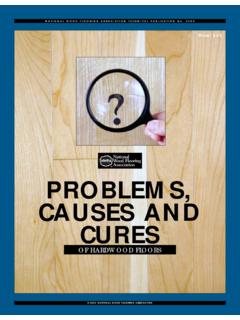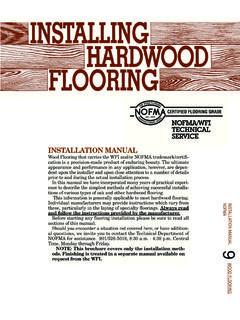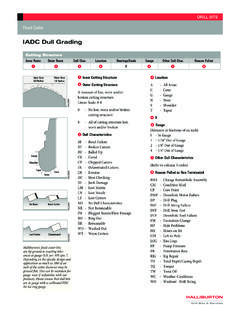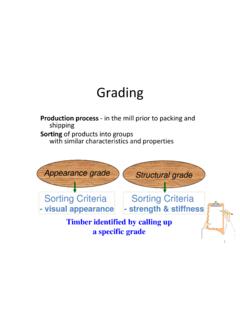Transcription of GRADING AND PACKAGING - Crescent Hardwood
1 GRADING ANDPACKAGING 1999 NATIONAL WOOD FLOORING ASSOCIATIONNATIONAL WOOD FLOORING ASSOCIATION TECHNICAL PUBLICATION No. A500 Price: $30 2 1999 NATIONAL WOOD FLOORING ASSOCIATIONNATIONAL WOOD FLOORING ASSOCIATION TECHNICAL PUBLICATION No. A500 CONTENTSGRADING AND PACKAGINGNO GUARANTEE OR WARRANTYThe information contained in this publication represents widely accepted industry practices. There are, however, no universally approvedflooring grades. The National Wood Flooring Association accepts no risk or liability for application of the information contained in :Why We Have Grades4 NATIONAL OAK FLOORINGMANUFACTURERS ASSOCIATIONWho Is NOFMAH andling of GRADING Disputes5 MAPLE FLOORINGMANUFACTURERS ASSOCIATIONWho Is MFMAH andling of GRADING Disputes6 CANADIAN LUMBERMEN SASSOCIATIONWho Is CLAH andling of GRADING Disputes7 OTHER GRADESL umber GradesSoftwoodsMill RunProprietary GradesImported Wood9 MEASURING WOOD FLOORINGS quare FootBoard FootLineal FootEqual Lineal FootCubic FootSquare MeterPackaging10 USEFUL FORMULAS11 THE TALLY SHEET13 GLOSSARY14 RESOURCE LIST15 APPENDIXNOFMA GradesMFMA GradesCLA Grades26 INDEX27 SOURCES AND CREDITS tial part of doing business in the Hardwood floorindustry.
2 Grades group flooring with similar quali-ties, bringing a degree of consistency to productsfrom different mills. Grades tell the purchaser theminimum to expect when buying product, includingsurface characteristics, required lengths and millingtolerances. Grades also help ensure that money isn twasted either by consumers or producers buyerscan confidently expect to get the quality of productthey pay for, and manufacturers know they aren twasting money by selling high-quality product at alower-quality some cases, grades are established by industryassociations, such as the National Oak Flooring Man-ufacturers Association and the Maple Flooring Manu-facturers Association. The development of hardwoodflooring grades was the main impetus in the forma-tion of those groups.
3 Association guidelines apply tomore than 90 percent of the solid flooring manufac-tured in the United States and Canada. In addition tocreating grades,the associationsprovide an impar-tial party to settledisputes aboutgrading and per-form be membersof such associa-tions to qualify fortheir GRADING dis-pute service. Inother cases, hard-wood flooring man-ufacturersdetermine theirown classificationsand create theirown grades, or proprietarygrades, by whichthey sell their floor-ing. NATIONAL WOOD FLOORING ASSOCIATION TECHNICAL PUBLICATION No. A500 Introduction: Why We HaveGradesPeople have been using Hardwood floors forhundreds of years examples can be found insome of the oldest castles and palaces inEurope. In the era when those floors were laid, hard-wood floors were constructed by hand in every aspect,from cutting down the lumber to applying the the advent of Hardwood floor manufacturingmachinery, however, an entire industry was installing, sanding and finishing a floorremained a specialized skill, creating the floors them-selves was no longer a painstaking process.
4 Aroundthe turn of the century, mills were established specifi-cally for the production of Hardwood floors. Not longafter, the burgeoning wood flooring industry saw theneed to implement standards, or , nearly a century later, GRADING is an essen- GRADING ANDPACKAGING 1999 NATIONAL WOOD FLOORING ASSOCIATION3 Grades were developed to bring a degree of consistency to wood 1999 NATIONAL WOOD FLOORING ASSOCIATIONNATIONAL WOOD FLOORING ASSOCIATION TECHNICAL PUBLICATION No. A500 WHO IS NOFMAThe National Oak Flooring Manufacturers Associ-ation traces its beginnings to Detroit in 1909,with the formation of the Oak Flooring Manufac-turers of the United States. The organization had sev-eral goals: to administer and promote industry gradingrules, to provide statistical data and to act as a generalspokesman for the being located in Chicago andCincinnati, the headquarters were movedto Memphis in 1930 and in 1933 the groupjoined with the Southern Oak FlooringIndustries organization to form association was to act as an agency ofthe Lumber Code authority for the admin-istration of a Code of Fair Competitionunder provisions of the National IndustrialRecovery Act.
5 In 1935, the association scharter was amended to authorize the orga-nization to operate as a trade association for thebenefit of the producers of oak and production through the yearspeaked in 1955, with 85 member manufacturersand billion board feet shipped, and subsequentlynose-dived in the 1960s with the popularity of car-peting. By 1979, membership was less than 10 per-cent of the 1955 peak. Since 1980, however, it hassteadily increased, with shipments in 1997 million board feet the most since , NOFMA continues its purpose of adminis-tering standards, performing quarterly mill inspec-tions, promoting the industry and gatheringstatistical information. Inspectors check for gradecompliance, including milling, PACKAGING length andacceptable moisture levels.
6 NOFMA also strives toeducate installers with semi-annual installationschools held in Memphis in conjunction with theNational Wood Flooring Association and the MapleFlooring Manufacturers Association. The associationprovides technical assistance, such as advice oninstallation, as s grades are now accepted so widely thateven non-member mills often separate their produc-tion of flooring along NOFMA guidelines. In additionto unfinished oak, beech, birch, maple, ash andhickory/pecan, NOFMA has grades for prefinishedoak mills pledge to support the NOFMA stan-dards to ensure that a NOFMA grade from any mem-ber mill will be roughly the equivalent of the samegrade from another member OF GRADING DISPUTESThe NOFMA inspection department has the respon-sibility of rendering complaint inspection reports formember mills.
7 According to NOFMA Rules & Regula-tions, an impartial opinion will be rendered on mat-ters of controversy between users and inspections can be madeonly on NOFMA member flooring, andcan be authorized only by a NOFMA member mill in good standing. Theauthorization must be received from themanufacturer whose product is inquestion. When making inspections,NOFMA inspectors review pertinentinformation and inspect job site condi-tions, installation procedures and thecondition of the flooring at the designatedsite and warehouse, if necessary. They alsomay provide direction for the removal of sampleflooring from the inspection to NOFMA for expenses of the complaintinspection is the responsibility of the manufacturerwhose flooring is involved. Settlement of the cost ofthe complaint is determined by the parties inspection reports are sent to themember manufacturer involved, unless the memberhas authorized other distribution.
8 When a complainton grade involves a shipment or installation, if thecomplaint inspection results in a difference in favorof the purchaser of more than five percent in feet,then the shipper will be considered as being in thewrong. If the difference is only five percent or less infeet, then the party making the complaint is consid-ered as being in the wrong. The quality and condi-tion of the Hardwood flooring as it leaves themanufacturer governs the does not accept any responsibility for: the arbitration of claims financial losses to anyone as a result of com-plaint inspections enforcement of agreements between buyer and seller collection of complaint inspection fees unpaid byflooring users to the manufacturer the future performance of flooring when sugges-tions for correction prove complete NOFMA grade rules, see the appendix onpage 1999 NATIONAL WOOD FLOORING ASSOCIATION5 NATIONAL WOOD FLOORING ASSOCIATION TECHNICAL PUBLICATION No.
9 A500 WHO IS MFMAThe Maple Flooring Manufacturers Associationhas strived to be the authoritative source oftechnical information about hard maple floor-ing since its founding in 1897, when most mapleflooring was produced for industrial use. Until thatyear, maple flooring manufacturers had establishedtheir own grades, grade terms and dimensions of theflooring. The founding of the MFMA brought standardization of the gradesand product to the industry. In its beginnings, the associationcollected statistics from its membermills including sales volumes, pricesand mill wages. By 1905, the associa-tion managed to guarantee the qualityof the GRADING after an inspector wasadded to the staff. GRADING standardsevolved over the decades, with thebasic standards used today (withminor revisions) having been established in the1940s.
10 The association also actively advertisedmaple flooring to the membership and production numbersfollowed the pattern of the industry, coming to anear standstill during the Depression and again inthe 1960s as carpet entered the market. By then,the manufacturing focus had changed to produc-tion of sports floors, where it remains today,although maple has greatly increased in residentialpopularity, as membership has beenexpanded over the years to includeassociate members (installers), distrib-utor members (wholesalers involved inthe sale of member mills products),allied members (manufacturers ofproducts utilized in the installation ofmaple, beech or birch flooring), andhonorary members (determined bythe Board of Directors).Today, MFMA continues toactively promote the product (nowincluding birch and beech flooring), as well asenforce grade standards.









